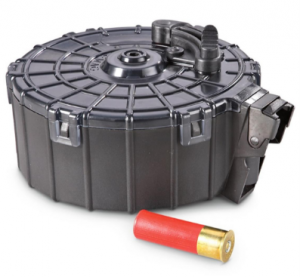 A question that arises quite frequently concerns the interpretation of the ‘like kind‘ language in the Virginia ban on Striker 12 Street Sweeper shotguns.
A question that arises quite frequently concerns the interpretation of the ‘like kind‘ language in the Virginia ban on Striker 12 Street Sweeper shotguns.
With the popularity of semi-auto shotguns such as the Saiga and Vepr 12, these questions are understandable.
Today I was asked this question yet again by a long-time client and I thought the answer might be of interest to others.
His questions could be paraphrased as follows:
In a Saiga or Vepr semi-auto 12 gauge shotgun with a folding stock:
- Is it legal to use any box magazine regardless of capacity?
- Is a 10 round drum magazine allowable?
- What about a 20 round drum magazine? Since the statute specifically requires a 12 round magazine wouldn’t a 20 be acceptable?
Let’s start by looking at the applicable statute which is § 18.2-308.8 of the Code of Virginia. It reads as follows:
“It shall be unlawful for any person to import, sell, possess or transfer the following firearms: the Striker 12, commonly called a “streetsweeper,” or any semi-automatic folding stock shotgun of like kind with a spring tension drum magazine capable of holding twelve shotgun shells. A violation of this section shall be punishable as a Class 6 felony.”
Breaking the prohibition down, we see that the ‘like kind‘ language requires that, in order to be prohibited, a firearm must be:
- A semi-auto …
- shotgun …
- with a folding stock …
- with a spring tension drum magazine …
- that is capable of holding 12 shotgun shells
Now that we have broken down the requirements, let’s answer the 3 questions above.
- Is it legal to use any box magazine regardless of capacity?
- “Yes. In order to fall under the prohibition, a firearm must have a spring tension drum magazine. A box magazine would fall outside the prohibition.”
- Is a 10 round drum magazine allowable?
- “Yes. A 10 round drum magazine is not ‘capable of holding 12 shotgun shells’ and therefore that configuration would fall outside the prohibition.”
- What about a 20 round drum magazine? Since the statute specifically requires a 12 round magazine wouldn’t a 20 be acceptable?
- “No! The statute does not require that the magazine be exactly 12 rounds, only that it be ‘capable of holding twelve shotgun shells’, which a 20 round drum certainly is capable of. Anyone who interprets this statute to only prohibit drum magazines which hold exactly 12 rounds subject themselves to a significant risk of prosecution and conviction!”
I hope this clarifies the issue somewhat. The good news is that one can take either of these shotguns (or any other semi-auto shotgun capable of holding a drum magazine) completely out of the purview of this statute by removing the folding stock and replacing it with a fixed stock.
NOTE: This analysis governs ‘like kind‘ shotguns that are not NFA items. As I explained in this article, the Striker 12 Street Sweeper itself is now classified as an NFA item.

 As a nation we tend to talk about ‘rights’ and ‘freedoms’ as if they were something inevitable. But a quick look around the world will demonstrate the folly of that assumption. The ‘freedoms’ we enjoy and the ‘rights’ we claim were purchased in the coin of sacrifice, blood, and lives; and the same price is required to maintain them.
As a nation we tend to talk about ‘rights’ and ‘freedoms’ as if they were something inevitable. But a quick look around the world will demonstrate the folly of that assumption. The ‘freedoms’ we enjoy and the ‘rights’ we claim were purchased in the coin of sacrifice, blood, and lives; and the same price is required to maintain them. I received a call earlier today from one of my FFL clients asking about this topic.
I received a call earlier today from one of my FFL clients asking about this topic.
 I have written before about the differences between Virginia law and federal law where
I have written before about the differences between Virginia law and federal law where  I received an email this morning from a client asking whether or not they could add a bipod to their pistol without making it an AOW.
I received an email this morning from a client asking whether or not they could add a bipod to their pistol without making it an AOW.




